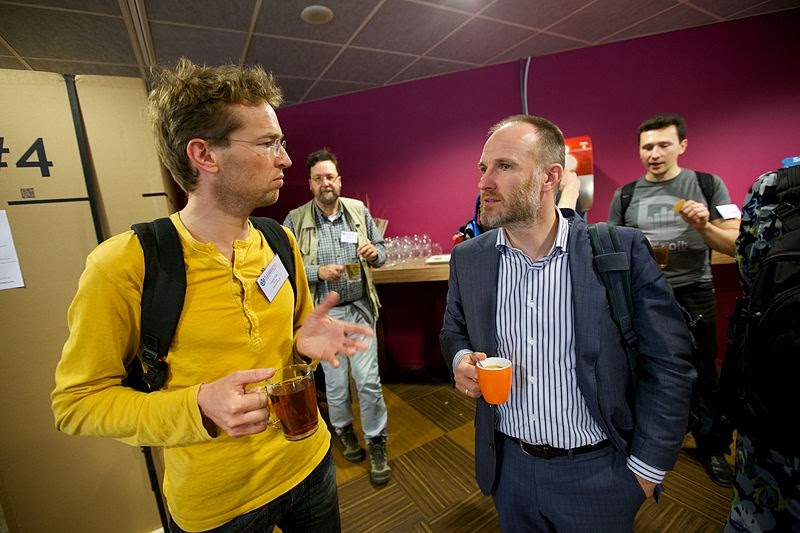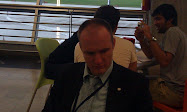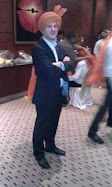I met him on February 20, 2004 when he started as a temp at the Wall Street Journal Europe in my department. A young man, still a student, heavy bearded, Davy Drieghe. Quite unexpectedly he became a full time employee and strongholder of the department. He stuck his teeth in the distribution operations of our newspaper with an appetite and lust I had rarely seen. Then, as all good things in life, he left his first job to be able to grow beyond our means. He left us for... our competitor The International Herald Tribune based in Paris. Only free spirits and adventurers are able to part from their comfort zone for an uncertain future abroad. But his gamble is paying off, this week he was allowed to follow a management training in the US and to visit the mother house of The International Herald Tribune, the New York Times. If you're interested in media power play, enjoy below account of his walk through newspaper history.
Walking through newspaper history by Davy Drieghe
... On my way from the hotel to The New York Times I suddenly found myself on Herald Square. The square is named after the New York Herald, established in 1835 and originally headquartered there. The little park in the middle of the square is named Horace Greeley Square, after the New York Tribune publisher, the NY Heralds big gest competitor which was founded in 1841. The New York Herald obtained its rival the New York Tribune in 1924 and changed its name into New York Herald Tribune.
gest competitor which was founded in 1841. The New York Herald obtained its rival the New York Tribune in 1924 and changed its name into New York Herald Tribune.
In 1966 the New York Herald Tribune closes down. The Paris branch, founded in 1887 under the name Paris Herald as an international outpost of the NY Herald, continues in joined ownership of New York Times and the Washington Post and is renamed the International Herald Tribune. In 2003 the New York Times takes over the Washington Post shares and becomes the sole owner of IHT. [As a countermove the Washington Post will join the Wall Street Journal in a loose partnership.]
Picture 1 to the right: New York Herald Building anno 1895, demolished in 1921 (photo: Wikipedia). Note the owls on the roof top; one remaining owl still can be found in the lobby of IHT in Paris.
 Picture 2: Herald Square (photo: Davy Drieghe) , in the back “Macy’s”.
Picture 2: Herald Square (photo: Davy Drieghe) , in the back “Macy’s”.
The New York Times itself used to be located on Times Square, famous for the annual New Years Eve countdown, and gave the square its current name. The NYT offices however moved almost 1 century ago to a less visible location on 43rd , a side street of Times Square. Later this year the NYT will move to a brand new and more visible office tower on the corner of 8th Avenue and Times Square, reclaiming its presence in New York.
Picture 3 to the right : NYT office on 43rd street.
Walking through newspaper history by Davy Drieghe
... On my way from the hotel to The New York Times I suddenly found myself on Herald Square. The square is named after the New York Herald, established in 1835 and originally headquartered there. The little park in the middle of the square is named Horace Greeley Square, after the New York Tribune publisher, the NY Heralds big
 gest competitor which was founded in 1841. The New York Herald obtained its rival the New York Tribune in 1924 and changed its name into New York Herald Tribune.
gest competitor which was founded in 1841. The New York Herald obtained its rival the New York Tribune in 1924 and changed its name into New York Herald Tribune.In 1966 the New York Herald Tribune closes down. The Paris branch, founded in 1887 under the name Paris Herald as an international outpost of the NY Herald, continues in joined ownership of New York Times and the Washington Post and is renamed the International Herald Tribune. In 2003 the New York Times takes over the Washington Post shares and becomes the sole owner of IHT. [As a countermove the Washington Post will join the Wall Street Journal in a loose partnership.]
Picture 1 to the right: New York Herald Building anno 1895, demolished in 1921 (photo: Wikipedia). Note the owls on the roof top; one remaining owl still can be found in the lobby of IHT in Paris.
 Picture 2: Herald Square (photo: Davy Drieghe) , in the back “Macy’s”.
Picture 2: Herald Square (photo: Davy Drieghe) , in the back “Macy’s”.The New York Times itself used to be located on Times Square, famous for the annual New Years Eve countdown, and gave the square its current name. The NYT offices however moved almost 1 century ago to a less visible location on 43rd , a side street of Times Square. Later this year the NYT will move to a brand new and more visible office tower on the corner of 8th Avenue and Times Square, reclaiming its presence in New York.

Picture 3 to the right : NYT office on 43rd street.
Picture 4: New NYT building on 8th Avenue and Times Square, to be inaugurated in 2007.
The New York Times currently is the 3rd largest US newspaper in circulation, after USA Today and Wall Street Journal and is most renowned for its meaty Sunday editions. The International Herald Tribune remains one of the most influential newspapers available around the globe.
Picture 5 to the right: Sunday edition NYT
(Pictures 2-5: Davy Drieghe)











 Unexpected encounter at King's College (°1441 by Henry VI) in Cambridge.
Unexpected encounter at King's College (°1441 by Henry VI) in Cambridge. 


 The Judge Business School is the international business school of Cambridge University in England. Formerly known as The Institute of Management Studies the school was renamed after Britisch businessman Paul Judge, who donated 8 million Pounds in 1990. Each year approximately 110 students will follow the 12 month MBA program. Admission standards are known to be very strict. Most of the MBA students, about 90 %, come from abroad. The MBA program was ranked 15th worldwide by the Financial Times Global MBA Rankings 2007.
The Judge Business School is the international business school of Cambridge University in England. Formerly known as The Institute of Management Studies the school was renamed after Britisch businessman Paul Judge, who donated 8 million Pounds in 1990. Each year approximately 110 students will follow the 12 month MBA program. Admission standards are known to be very strict. Most of the MBA students, about 90 %, come from abroad. The MBA program was ranked 15th worldwide by the Financial Times Global MBA Rankings 2007.




















